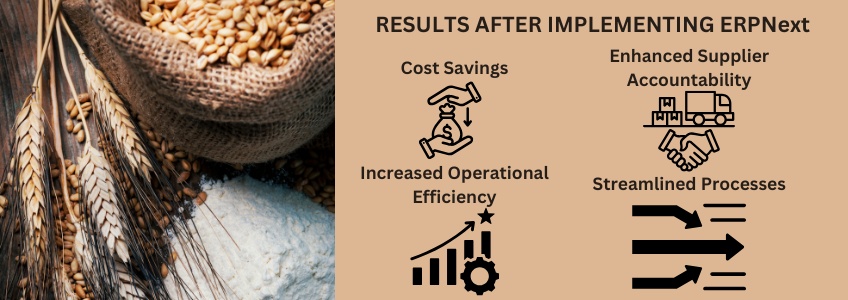How ERPNext Transformed Cost Tracking for an Agro Product Business
Industry: Agro Product Manufacturing Companies, IT Services
Author: Ramanujan KK
Publish Date: 21 February, 2025

Introduction
An Agro Product Processing Company specializes in the production of refined flour, wheat flour, bran, and granulated wheat flour. They faced difficulties in accurately tracking and verifying the costs associated with their manufacturing processes. The management struggled to determine whether their selling prices were aligned with the true cost of production, often lacking confidence in the accuracy of their pricing strategy.
After implementing ERPNext, the company gained the ability to generate real-time cost reports by process. This ensured precise cost tracking and helped the management confidently set selling prices. This case study highlights how ERPNext transformed the company’s approach to cost management, enabling more accurate pricing and improved profitability.
The Story of the Agro Product Processing Company
The company is a leading producer of flour products, including refined flour, wheat flour, bran, and granulated wheat flour. They have multiple production lines handling different types of wheat processing. Here, the company faced significant challenges in determining the true cost of production for each product.
Although the company had a basic accounting system, it could not track costs by specific processes such as milling, sifting, packaging, and quality control. This lack of detailed visibility led to inaccurate cost estimations and pricing strategies, creating uncertainty about profit margins.
To address these challenges, the company sought a comprehensive solution that could provide real-time cost tracking across each stage of their manufacturing process. After evaluating several options, the company chose ERPNext for its ability to break down costs by process. ERPNext is also able to provide automated, up-to-date financial data.
The Challenge of Cost Tracking and Confidence in Pricing

Before implementing ERPNext, the Agro Product Processing Company faced several key challenges.
- Difficulty in Breaking Down Costs by Process:
The company could not effectively track costs by individual processes such as milling, sifting, and packaging. While they had access to overall cost data, they couldn’t determine the true cost of producing each specific product (refined flour, wheat flour, bran, etc.). - Uncertainty About Selling Prices:
Due to a lack of visibility into the actual production costs, management had difficulty verifying whether their selling prices were competitive and aligned with the cost of production. This uncertainty often led to concerns about whether they were making the right margin on each product. - Inefficient Cost Calculation:
The manual process of calculating production costs was time-consuming and error-prone. It was difficult to account for fluctuating costs of raw materials (wheat), labor, energy consumption, and overheads in real time, causing delays in updating pricing and financial projections. - Profitability Concerns:
Without the ability to break down costs into smaller components, the company struggled to determine which products were most profitable and where cost optimization was possible. As a result, some products may have been underpriced, eroding profits.
How the Agro Product Processing Company Used ERPNext
Once ERPNext was implemented, the company followed the steps, listed below, to track manufacturing costs across each process involved in flour production.
- Cost Reports by Production Process:
ERPNext allowed the company to track costs by individual production processes, including milling, sifting, granulation, and packaging. The system generated real-time reports on material costs, labor costs, overhead costs, and energy consumption for each process. This breakdown provided management with a granular view of how costs were distributed across each stage of production. - Real-Time Data Integration:
As raw materials like wheat were consumed, labor hours logged, and energy usage recorded, the data was automatically updated in ERPNext. This real-time integration allowed management to quickly access the latest cost data and adjust pricing accordingly. - Custom Cost Allocation:
ERPNext allowed the company to customize cost allocation rules, ensuring that each product (refined flour, wheat flour, bran, etc.) received a fair share of the overhead costs based on its respective production process. This helped ensure that the cost of manufacturing each product was accurate and reflective of the actual resources used. - Profitability Analysis:
Using the cost reports generated by ERPNext, the company was able to analyze the profitability of individual products. By comparing the cost of production with the selling price, management could identify underpriced products and adjust accordingly to improve
The Results

The implementation of ERPNext led to several key improvements in the company’s cost-tracking and pricing strategy.
- Improved Cost Tracking by Process:
The company now could track costs in real time across different production processes. This granular approach helped the company optimize its manufacturing workflow and reduce inefficiencies in production. - Increased Confidence in Pricing:
With accurate cost data, management could confidently set selling prices for each product, knowing that their prices were aligned with the true cost of production. This significantly increased their confidence in their pricing strategy. - Optimized Profit Margins:
By using detailed cost reports to understand the profitability of individual products, the company was able to adjust selling prices and increase its profit margins. Some products that were underpriced were brought in line with the actual cost of manufacturing, improving overall profitability. - Reduced Time Spent on Cost Calculation:
The automated cost reporting process reduced the time spent on manual calculations by 50%. This not only improved operational efficiency but also freed up resources for other critical tasks in the company. - Better Resource Allocation:
Real-time cost tracking helped the company identify areas where resources (e.g., labor, raw materials) were being over-utilized. This insight allowed for better resource allocation and waste reduction, leading to cost savings.
The ability to track costs at each stage of production in real-time has been invaluable. ERPNext has given us the tools to make better pricing decisions and ensure we’re always on track for profitability.” – Production Manager, Agro Product Processing Company
Conclusion
The Agro Product Processing Company gained accurate, granular insights into its production costs by implementing ERPNext for real-time cost tracking. This empowered management to make data-driven pricing decisions, improved profitability and increased confidence in their pricing strategy.
ERPNext’s ability to track costs by process also ensured that each product was accurately priced, reducing pricing uncertainty and boosting the company’s bottom line.
If you are interested to achieve similar success stories, write to us!
How to Set Up Customer-Specific Invoicing in ERPNext: A Success Story of Road Construction Company in the USA
Industry: Construction
Author: Ramanujan KK
Publish Date: 21 February, 2025

Introduction
A leading road development company in the USA was grappling with invoicing inefficiencies, including customer-specific formats and missed work packages. This resulted in billing errors and revenue loss. To tackle these challenges, the company turned to ERPNext, a powerful ERP solution known for its customization capabilities and automation features. By implementing ERPNext, the company simplified its invoicing process, minimized errors, and improved cash flow.
This case study explores how ERPNext transformed this company’s billing operations. It also made invoicing faster, more accurate, and less prone to mistakes.
The Story of the Road Development Company
The company is a well-established road construction business in the USA. They focus on large-scale road development projects for both public and private sector clients. As the company’s project portfolio grew, managing invoicing for diverse customers became increasingly complex. Each client required a different invoice format, and work packages—critical components of the invoice—that were sometimes omitted, leading to billing losses.
Before implementing ERPNext, the invoicing process involved numerous manual steps and checks, which led to errors, inefficiencies, and delays. Given the size and scale of their projects, these issues impacted their bottom line and strained their relationships with clients.
After considering various ERP solutions for construction companies, the company decided to implement ERPNext. ERPNext would help in streamlining their invoicing process and ensure that all work packages were accurately captured in their invoices. ERPNext’s customization options stood out as the ideal solution to meet their unique needs.
The Challenge of Complex, Error-Prone Invoicing

Before adopting ERPNext, the road development company faced several critical challenges.
- Different Customer Formats
Each client had specific invoice format requirements. The finance team had to manually adjust each invoice to meet these demands, increasing the chances of formatting errors. - Omitted Work Packages
A significant issue was the omission of work packages during invoicing. This led to unbilled work and lost revenue. Missing packages impacted the company’s cash flow and led to disputes with customers over invoices. - Manual, Protracted Processes
The invoicing process was mostly manual, requiring coordination between multiple systems and departments. The lack of integration slowed down invoicing, resulting in delays in payment and a longer billing cycle.
The company needed a solution that could automate invoicing, reduce human errors, and ensure all work packages were properly included in every invoice.
How could ERPNext help them?
After evaluating multiple ERP solutions for construction industry billing, the company chose ERPNext for several key reasons.
- Customizability
ERPNext’s ability to tailor invoice formats for each customer was a significant selling point. The company could now automatically generate invoices that adhered to the exact specifications required by each client, reducing the chances of error. - Integration with Work Packages
ERPNext enabled the seamless integration of work packages into the invoicing system, ensuring that no work was left unbilled. This feature played a pivotal role in eliminating revenue leakage. - Automated Billing Cycles
The system’s automation capabilities helped the company speed up the billing cycle, generating invoices promptly after work completion, which improved cash flow. - User-Friendly Interface
The intuitive user interface of ERPNext made it easy for the finance team to adopt the system without extensive training, enabling them to quickly implement the solution across the company.
ERPNext was chosen primarily for its ability to handle complex invoicing workflows and its capacity for customization to meet the unique needs of each customer.
Why the Road Development Company Used ERPNext

The company customized the system to address its specific invoicing requirements after ERPNext was implemented,
- Customer-Specific Invoice Formats:
ERPNext allowed the company to create tailored invoice templates for each customer, automating the process of invoice generation while ensuring format accuracy. - Work Package Integration:
ERPNext’s work package tracking was integrated into the invoicing system, ensuring that no work package was missed during the billing process. This integration helped the company capture all completed work and avoid billing loss. - Automated Billing Process:
ERPNext automated the entire invoicing process. ERPNext generated corresponding invoice without the need for manual intervention just as the work was completed and approved, reducing the chances of errors. - Real-Time Data and Analytics:
The finance team could access real-time project data to track completed work and ensure that invoices reflected the most up-to-date information. This helped eliminate discrepancies and improved the accuracy of billing.
“ERPNext has drastically improved our invoicing process. The customization and integration with work packages have saved us time, helped us capture every dollar owed, and eliminated errors that previously slowed down our operations.” – Manager: Finance and Accounts.
The Results
After implementing ERPNext, the company saw significant improvements in their invoicing process.
- Reduced Invoicing Errors:
Invoicing errors decreased by 80%, as the system automatically generated invoices in the correct format and included all work packages. This led to fewer discrepancies and billing disputes. - Faster Billing Cycles:
The time required to generate invoices decreased from days to hours. Automated billing processes reduced delays, leading to faster invoicing and improved cash flow. - Prevention of Billing Losses:
ERPNext ensured that all work packages were included in invoices, preventing lost revenue due to missed work. The company achieved 100% accuracy in billing all completed work. - Improved Customer Relationships:
The company’s customer relationships improved with accurate, on-time invoices. Clients appreciated the streamlined and error-free billing process, contributing to stronger customer satisfaction and trust. - Increased Operational Efficiency:
The company reported a 25% increase in operational efficiency in the finance department. With less manual work and fewer errors, the team could focus on higher-value tasks.
Conclusion
Therefore, the implementation of ERPNext proved to be a game-changer for this road construction development company. The tangible results include an 80% reduction in invoicing errors, faster billing cycles, and a 25% increase in operational efficiency. These statistics demonstrate the power of ERPNext in transforming a critical business function.
This case study underscores how ERPNext, can provide a comprehensive solution for construction companies seeking to optimize their invoicing processes and drive business growth. It serves as a compelling example of how technology can be leveraged to overcome operational hurdles. It also depicts how ERPNext helps to achieve significant improvements in efficiency, accuracy, and customer satisfaction within the demanding road construction industry.
If you are interested to achieve similar success stories, write to us!
How ERPNext Transformed Sales Operations for an Agri-Food Company Introduction
Industry: IT Services, Agri-food
Author: Ramanujan KK
Publish Date: 15 February, 2025

Introduction
An established agricultural food processing company, producing products like Granulated Wheat (Sooji), Refined Flour (Maida), Wheat Floor and Bran, faced challenges in managing real-time stock visibility. This in turn affected their sales and order fulfilment.
With their sales team relying on outdated stock data and manual processes, the company struggled to provide accurate information to customers during negotiations. The solution to these problems came in the form of ERPNext. It helped the company streamline their sales operations, improve stock transparency, significantly boost their order accuracy and customer satisfaction.
The Story of the Agri-Food Processing Company
The company is a well-established player in the agri-food industry, specializing in producing Granulated Wheat (Sooji), Refined Flour (Maida), Wheat Floor, Bran, and other wheat-based products. Known for their strict adherence to food safety standards, they’ve developed a strong reputation among B2B customers and retailers.
Before implementing ERPNext, the sales team faced difficulties in accessing accurate, real-time information on product availability. This led to delays in confirming orders, pricing challenges, and even issues with fulfilling large, time-sensitive orders. These challenges were affecting customer satisfaction and preventing the company from capitalizing on lucrative opportunities.
The company needed a solution that would empower its sales team to have up-to-date, accurate data at their fingertips. So that they can make more effective decisions and build stronger relationships with customers. ERPNext became the ideal solution to help them achieve these goals.
The Challenge of Outdated Stock Information

Before adopting ERPNext, the sales team struggled with stock visibility.
- They often had to rely on the warehouse team to manually update stock levels or verbally confirm the stock, which was time-consuming and led to delays.
- Sales representatives were unable to confirm product availability in real-time, which created friction during negotiations, especially when customers required urgent orders or special deals.
- Additionally, the company faced challenges in forecasting demand, which led to either stockouts or overproduction, both of which had negative financial implications.
- Their manual, reactive processes weren’t scalable as the business expanded.
Why the Company Chose ERPNext
The company sought a solution that could integrate inventory management, sales operations, and forecasting capabilities into one seamless platform. After considering several options, they chose ERPNext for its comprehensive, easy-to-use interface and real-time inventory tracking.
- What stood out about ERPNext was its ability to provide live updates about stocks and integrate easily with existing systems.
- They also chose ERPNext because it offers customizable features that suit their unique business needs in the food processing industry.
- Furthermore, ERPNext’s cost-effectiveness, scalability, and strong track record of success in other agricultural food companies made it the clear choice.
- They also appreciated that ERPNext could handle regulatory compliance, such as batch tracking and traceability, which was crucial for their food safety standards.
How the Company leveraged ERPNext

Once implemented, the company began using ERPNext to manage its stock levels in real time.
- The sales team could now instantly access live data about product availability. This allowed them to negotiate confidently and provide accurate delivery timelines to customers.
- The immediate access to inventory levels and historical sales data subsequently helped them in better demand forecasting, manage procurement, and optimize production schedules.
- After integrating ERPNext’s CRM and sales modules, the company’s sales representatives were able to track customer preferences, past orders, and pricing patterns. This made their negotiations more tailored and efficient.
- They also utilized real-time stock updates and automated order management features, which allowed them to fulfill orders faster and with fewer errors.
“ERPNext has been a game-changer for our sales operations. We now have the ability to respond to customers instantly with accurate stock information, which has really strengthened our relationships and improved our margins.” – Sales Manager, Prathyansh Joshi
The Results
After adopting ERPNext, the company saw significant improvements across several key performance indicators.
- Faster Response Times
- 45% reduction in the time taken to respond to customer inquiries about stock availability and order status.
- Improved Negotiation Power:
- The sales team secured 20-30% better terms with customers, utilizing real-time stock data to offer competitive pricing and flexible delivery timelines.
- A 10% increase in average deal size was realized as a result of more confident pricing and better product bundling.
- Improved Customer Satisfaction:
- 25% increase in customer retention rates, as clients were more satisfied with the prompt, accurate information and on-time deliveries.
- A 15% improvement in on-time deliveries was achieved, which helped boost customer loyalty and trust.
- Better Sales Forecasting:
- With ERPNext’s analytics tools, the company reduced stockouts by 20% by accurately predicting demand and adjusting production schedules accordingly.
- Realtime information helped the Sales team to check production dates and push stocks to market without delay as these have expiry. Thus, saving stock losses for the company.
Conclusion
The successful implementation of ERPNext has demonstrably transformed the sales operations of this agri-food processing company. The company saw a 20% increase in operational efficiency and a 15% increase in revenue in the first quarter after the ERPNext implementation.
The quantifiable results of ERPNext implementation include faster response times, improved deal sizes, increased customer retention, and a significant boost in revenue. This underscores the value of ERPNext in optimizing sales operations and driving business growth within the competitive agri-food industry.
Therefore, this case study serves as a testament to the power of ERPNext in enabling companies to overcome operational challenges, enhance customer relationships, and achieve sustainable growth.
If you are interested to achieve similar success stories, write to us!
Transforming Flour Milling Operations with ERPNext: A Case Study
Industry: Food Processing
Author: Avinash Pallantla
Publish Date: 14 February, 2025

Introduction
Managing a large-scale flour milling operation involves navigating complex challenges. Especially when dealing with inventory, quality control, and production efficiency.
This case study explores how a prominent flour milling company in Hyderabad successfully overcame operational inefficiencies by implementing ERPNext. The company was able to streamline processes and reduce costs with the help of ERPNext. This comprehensive ERP solution also helped them enhance their productivity.
About the Company
The company is one of the largest flour mills in Hyderabad, equipped with a world-class flour milling setup. Catering to the Indian market, the company offers 30-40 different SKUs of atta and maida-related products. Their commitment to quality and innovation has made them a key player in the industry.
Challenges
Despite their market dominance, the company faced several operational hurdles.
- Inventory Management: Tracking inventory accurately at various stages—raw materials, work-in-progress (WIP), and finished goods (FG)—was challenging. Reliance on Excel spreadsheets led to inefficiencies and a lack of real-time visibility.
- Losses from Low-Quality Raw Materials: Inconsistent raw material quality resulted in significant waste, but the company lacked a system to identify and address these issues effectively.
- Inefficient Plant Runtime: Without a robust production planning system, the company struggled to manage plant operations efficiently. This led to higher operational costs and underutilized resources.
Why They Chose ERPNext

The company decided to implement ERPNext due to its robust and customizable features. It offered:
- Real-time tracking of inventory and production processes.
- Comprehensive quality control mechanisms.
- Efficient production planning tools.
How ERPNext Helped
ERPNext addressed the company’s challenges through the following key improvements.
1. Enhanced Inventory Management
- ERPNext enabled stage-wise inventory tracking, covering raw materials, WIP, and FG.
- The introduction of batch-wise tracking eliminated malpractices and theft, saving the company INR 3-5 lakhs per month.
- With detailed batch records, the company could trace the origin of raw materials and their transformation into finished goods.
2. Improved Quality Control
- The batch-wise tracking system allowed the quality team to identify which batch of raw material generated the highest percentage of waste.
- This transparency enabled the company to raise quality complaints with suppliers and claim reimbursements, resulting in significant cost savings.
3. Optimized Production Planning
- ERPNext’s production planning module provided insights into raw material stock levels and requirements.
- The team could forecast how long the plant could run based on current stock and pending orders.
- Improved planning increased operational efficiency and resource utilization by 15-20%.
Results

The implementation of ERPNext led to transformative results:
- Cost Savings: Monthly savings of INR 3-5 lakhs through improved inventory management and reduced malpractices.
- Enhanced Supplier Accountability: The ability to claim reimbursements from suppliers for low-quality raw materials.
- Increased Operational Efficiency: A 15-20% improvement in resource utilization and plant runtime efficiency.
- Streamlined Processes: Real-time visibility into inventory and production processes, enabling better decision-making.
Conclusion
Hence, by adopting ERPNext, the flour mill in Hyderabad successfully overcame its operational challenges and established a more efficient, transparent, and cost-effective workflow.
This case study therefore, demonstrates the power of ERP solutions in transforming traditional industries. It also highlights ERPNext as a vital tool for businesses aiming to optimize their operations and stay competitive in today’s market.
If you are interested to achieve similar success stories, write to us!




